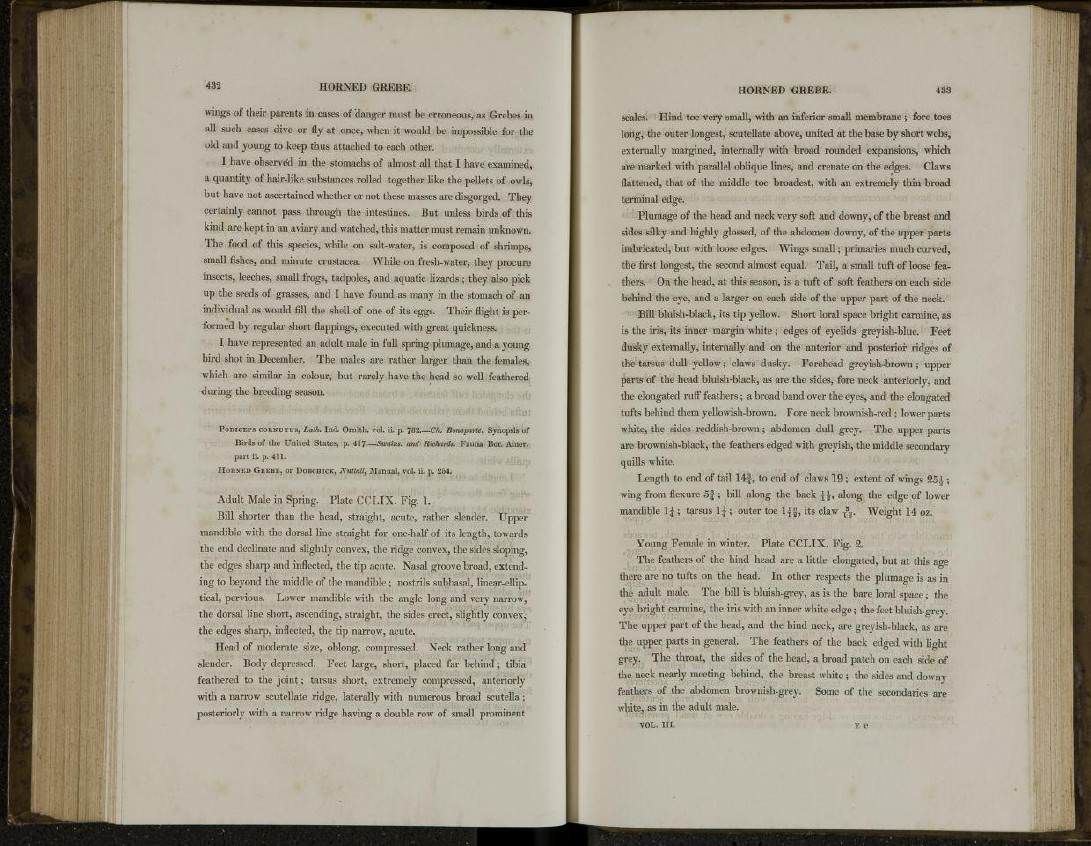
wings of their parents in cases of danger must be erroneous, as Grebes in
all such cases dive or fly at once, when it would be impossible for the
old and young to keep thus attached to each other.
I have observe'd in the stomachs of almost all that I have examined,
a quantity of hair-like substances rolled together like the pellets of owls,
but have not ascertained whether or not these masses are disgorged. They
certainly cannot pass through the intestines. But unless birds of this
kind are kept in an aviary and watched, this matter must remain unknown.
The food of this species, while on salt-water, is composed of shrimps,
small fishes, and minute Crustacea. While on fresh-water, they procure
insects, leeches, small frogs, tadpoles, and aquatic lizards; they also pick
up the seeds of grasses, and I have found as many in the stomach of an
individual as would fill the shell of one of its eggs. Their flight is performed
by regular short flappings, executed with great quickness.
I have represented an adult male in full spring plumage, and a young
bird shot in December. The males are rather larger than the females,
which are similar in colour, but rarely have the head so well feathered
during the breeding season.
PODICEPS CORNCTUS, Lath. Ind. Ornith. vol. ii. p. 782.—Ch. Bonaparte, Synopsis of
Birds of the United States, p. 417—Swains, and Richards. Fauna Bor. Araer.
part ii. p. 4 1 1 .
HORNED GREBE, or DOBCHICK, Nuttall, Manual, vol. ii. p. 2 5 4 .
Adult Male in Spring. Plate CCLIX. Fig. 1.
Bill shorter than the head, straight, acute, rather slender. Upper
mandible with the dorsal line straight for one-half of its length, towards
the end declinate and slightly convex, the ridge convex, the sides sloping,
the edges sharp and inflected, the tip acute. Nasal groove broad, extending
to beyond the middle of the mandible ; nostrils subbasal, linear-elliptical,
pervious. Lower mandible with the angle long and very narrow,
the dorsal line short, ascending, straight, the sides erect, slightly convex,
the edges sharp, inflected, the tip narrow, acute.
Head of moderate size, oblong, compressed. Neck rather long and
slender. Body depressed. Feet large, short, placed far behind ; tibia
feathered to the joint; tarsus short, extremely compressed, anteriorly
with a narrow scutellate ridge, laterally with numerous broad scutella;
posteriorly with a narrow ridge having a double row of small prominent
scales. Hind toe very small, with an inferior small membrane ; fore toes
long, the outer longest, scutellate above, united at the base by short webs,
externally margined, internally with broad rounded expansions, which
are marked with parallel oblique lines, and crenate on the edges. Claws
flattened, that of the middle toe broadest, with an extremely thin broad
terminal edge.
Plumage of the head and neck very soft and downy, of the breast and
sides silky and highly glossed, of the abdomen downy, of the upper parts
imbricated, but with loose edges. Wings small; primaries much curved,
the first longest, the second almost equal. Tail, a small tuft of loose feathers.
On the head, at this season, is a tuft of soft feathers on each side
behind the eye, and a larger on each side of the upper part of the neck.
Bill bluish-black, its tip yellow. Short loral space bright carmine, as
is the iris, its inner margin white ; edges of eyelids greyish-blue. Feet
dusky externally, internally and on the anterior and posterior ridges of
the tarsus dull yellow; claws dusky. Forehead greyish-brown; upper
parts of the head bluish-black, as are the sides, fore neck anteriorly, and
the elongated ruff feathers; a broad band over the eyes, and the elongated
tufts behind them yellowish-brown. Fore neck brownish-red ; lower parts
white, the sides reddish-brown; abdomen dull grey. The upper parts
are brownish-black, the feathers edged with greyish, the middle secondary
quills white.
Length to end of tail 14|, to end of claws 19 ; extent of wings 2 5 | ;
wing from flexure 5 | ; bill along the back \ \ % along the edge of lower
Young Female in winter. Plate CCLIX. Fig. 2.
The feathers of the hind head are a little elongated, but at this age
there are no tufts on the head. In other respects the plumage is as in
the adult male. The bill is bluish-grey, as is the bare loral space; the
eye bright carmine, the iris with an inner white edge; the feet bluish-grey.
The upper part of the head, and the hind neck, are greyish-black, as are
the upper parts in general. The feathers of the back edged with light
grey. The throat, the sides of the head, a broad patch on each side of
the neck nearly meeting behind, the breast white; the sides and downy
feathers of the abdomen brownish-grey. Some of the secondaries are
white, as in the adult male.
VOL. in. E e